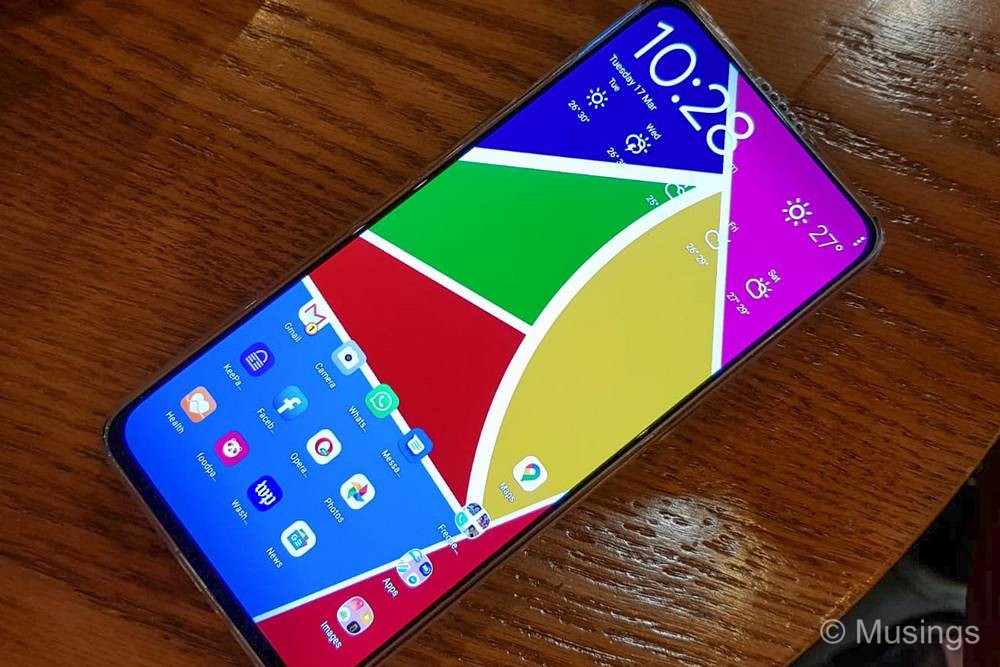A follow-up post of sorts to my last post on new technological features found on the new wave of smartphones. I’ve had the Oppo Reno 10x Zoom for about nine months now, so about time to do a post on how it’s been over this period of use.
From a physical design point of view, the Oppo Reno’s general aesthetic has fared well compared with how the first 2020 phones are now looking. Phones with ultra-slim/near bezeless and no/super small camera notches are the rage now, and it’s rare to see a mainstream mid-range or higher phone released today that doesn’t conform to this expectation. Interestingly, the just announced Oppo Find X2 Pro – a stunner that matches and possibly even exceeds some aspects of the Samsung S20 Ultra – has done away with pop-up cameras, possibly in part of Oppo’s wanting to improve the phone’s rated water resistance or proof-ness. The Oppo Reno feels hefty and thick at 210g and 9.3mm, especially considering its 6.6″ screen-size: comparative phones of today are basically lighter and slightly thinner.
A lesson learned too since my Samsung Note 9 days: a screen that’s protected by Gorilla Glass doesn’t mean that it won’t get scratches on the front screen. Both the Note 9 suffered small but visible scratches on the screen just a month after purchase. I had a nano screen protector applied on the Oppo Reno while in Fukuoka last year, but that also wasn’t enough: the first scratches also appeared on it in December. The nano screen’s oleophobic coating layer likewise stayed on for about two months before the layer also eroded. And to clarify: I’m pretty gentle with my phones!
Related to that is the industry’s current fad with curved screens. The Oppo Reno has a mostly flat display screen, with just a very gentle curve along its edges. But even then, it was incredibly difficult to find 100% coverage tempered glass protectors, since it’s cheaper and easier by far to make glass protectors that don’t curve at the edges, nevermind too that gaps too will likely lead to dust particles seeping into the edges. My preference would be to avoid curved screens on my next smartphone, but industry seems to like them. More often than not, the new generation and just announced flagship smartphones that I’m interested in all have that ‘feature’. Gaaah.
The Oppo Reno’s 4,065mAh battery is large by last year’s standards, but only modest for 2020 for a phone of its class. The incredible battery life – rated by GSMArena at 14.19hs for web browsing – seems to have dropped significantly. For instance, the battery level would drop by just about 3-4% overnight each day. These days, the overnight drop is double-that.
The phone, oddly, still doesn’t play nice with Nova Launcher. WhatsApp notification badges routinely did not appear while using the launcher (in comparison, it works fine with Microsoft Launcher). Notification badges have worked fine with every phone I’ve installed third party Launchers with, so I reckon it’s an issue with Oppo’s ColorOS skin. Sad that the anomaly still hasn’t got properly ironed out at this point nine months into the phone.
I didn’t think I’d really be using one of the phone’s key headline features much: the camera’s 10x Zoom, and nope, I still haven’t really nine months of usage in. There’s just too much image degradation for my taste past 6x.
My last two phones before this Oppo Reno – the Samsung S8+ and Note 9 – were rated IP68 dust and water resistant. There isn’t as much fun as giving the phone a literal bath under running water haha. The Oppo Reno has no such resistance, but it wasn’t that much of a deal after all.
On the other hand, firmware updates from Oppo are pretty lethargic. According to Oppo’s roadmap, the date for the Reno to be bumped from Android 9 to 10 was supposed to have been last year. That got pushed down to March 2020, I assume in part also because of the evolving Covid-19 situation. Well, it’s past mid-March now, and the update still remains nowhere in sight.

My requirements for the next phone, probably sometime this year? Well, at least a 6.6” display with 90 Hz or higher refresh – no going back after large display phones like this Oppo Reno – 256GB storage, and if not, it needs to come with a MicroSD slot for expandable storage – stabilized 4K video capability, and also support for RAW or DNG. Nice to haves but not finally absolutely necessary: a QHD+ screen, flat display or at least one with minimal edge curves, support for H.265 video codecs, IP68 ratings, and whether the main camera is implemented as a pop-up or not to achieve a notchless display. The Samsung S20 series of phones have proven quite disappointing – judging from the first full reviews coming out now and specifically from price and also battery life perspectives – so here’s hoping that the new wave of manufacturers putting out phones with as high refresh displays will offer better battery longevity!
Recent comments